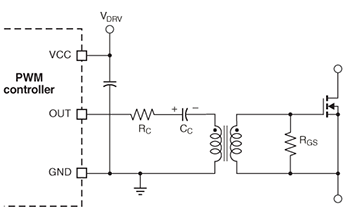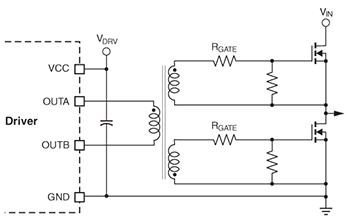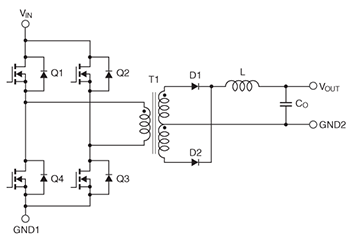 |
Shaanxi FKS Electronic Parts Import & Export Co.,Ltd.Xixian New Area FKS Electronic Technology Co.,Ltd. |
|
||||||
What is a gate drive transformer ?
What is a gate drive transformer?
Current through a MOSFET between drain and source is controlled by a drive voltage applied to the MOSFET gate. In switching power supplies a pulsed gate drive voltage turns the drain-source current on and off, operating the MOSFET as a current switch. Gate drive transformers are used to deliver the controlling pulses while providing isolation between the MOSFET and the controlling drive circuit. This article discusses gate drive transformers and applications for which FKS off-the-shelf gate drive transformers are best suited.
Gate driver circuits need an isolated (floating) bias supply to maintain the required turn-on bias when the FET source rises to the input voltage. A gate drive transformer isolates the controlling gate drive circuit from the switch node when driving the MOSFET gate, and may also scale the output voltage via an appropriate primary-to-secondary turns ratio.
In some applications, digital isolators or opto-couplers may provide the means to drive MOSFET’s directly, but gate drive transformers are preferred for higher-voltage requirements and have the advantage of much lower turn-on and turn-off delay times, as well as the capability to scale voltage by turns ratio. Therefore, gate drive transformers are often the best performing solution for high-voltage and high-frequency applications where fast and accurate signal timing is critical.
What does a typical gate drive transformer circuit look like?
Figure 1 shows a simplified single-output, transformer-coupled (AC-coupled), high-side gate drive circuit for lower power applications. Depending on duty cycle and other circuit conditions, additional components (capacitors, diodes and resistors) may be used, to prevent:
The development of a DC voltage across the transformer which would cause it to saturate
The magnetizing inductance and coupling capacitance from resonating with sudden changes in duty cycle
For single-ended (AC coupled) circuits the worst-case duty cycle is 0.50.

Half-bridge and full-bridge configurations (such as the transformer-coupled, push-pull half-bridge gate drive circuit shown in Figure 2) are used for higher-power applications.
For double-ended (DC-coupled) bridge configurations, the worst-case is the maximum duty cycle (theoretically 1.0).

Figure 3 illustrates a typical gate drive transformer solution where a full-bridge power stage is driven by both high-side (Q1 and Q2) and low-side (Q3 and Q4) MOSFETs.

What types of gate drive transformers does FKS manufacture?
Coilcraft has pre-designed, off-the-shelf gate drive transformers in a range of Volt-time product ratings, isolation ratings, and turns ratios.
How do I select the best Coilcraft gate drive transformer for my application?
FKS’s off-the-shelf gate drive transformers simplify the design of your gate drive circuit and shorten design cycle time. Our designs typically utilize high-permeability ferrite cores to maximize magnetizing inductance and minimize magnetizing current.
The required transformer size is determined by the volt-time product of the application. Therefore the first selection criterion for a gate drive transformer is the volt-time product (V-µsec) rating as shown on the transformer datasheet, and must be chosen greater than or equal to the expected highest applied voltage-time product to avoid core saturation.
Note: Volt-time product (V-µs) may be calculated from datasheet specifications, by multiplying the primary inductance at peak current (L @ Isat) by the peak current (Isat) rating. For example: Given (L @ Isat) = (33 µH @ 2 A) then V x T = 66 V-µs
You must also consider the following criteria when selecting a gate drive:
Turns ratio: Pri:Sec turns ratio needed for voltage scaling, typically 1:1 for gate drive
Isolation: the isolation rating should be selected for worst-case conditions
Leakage inductance: the lowest leakage inductance translates to the greatest efficiency and reduced time delays in the gate drive circuit
PCB mount style required: through-hole (TH) or surface-mount (SM)
Check out our selection of pre-designed off the shelf gate drive transformers for your single-ended or double-ended gate drive applications.
References
John Stevens. 2013. Using a Single-Output Gate-Driver for High-Side or Low-Side Drive. Texas Instruments Application Report SLUA669.
Laszlo Balogh. 2002. Fundamentals of MOSFET and IGBT Gate Driver Circuits. Texas Instruments Application Report SLUA618-March 2017-Revised SLUP169.
【 Go Back 】 | 【 Print 】 | 【 Close this window 】





